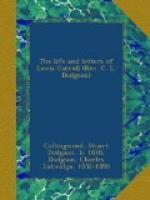My first—Sea. It carries the ships of the merchants.
My second—Weed.
That is, a cigar, an article much used
in jollifications.
My whole—Seaweed. Take a newly painted oil-picture; lay it on its back on the floor, and spread over it, “thinnish,” some wet seaweed. You will find you have “finished” that picture.
Yours affectionately,
C.L. Dodgson.
Lewis Carroll during the last fifteen years of his life always spent the Long Vacation at Eastbourne; in earlier times, Sandown, a pleasant little seaside resort in the Isle of Wight, was his summer abode. He loved the sea both for its own sake and because of the number of children whom he met at seaside places. Here is another “first meeting”; this time it is at Sandown, and Miss Gertrude Chataway is the narrator:—
I first met Mr. Lewis Carroll
on the sea-shore at Sandown in
the Isle of Wight, in the
summer of 1875, when I was quite a
little child.
We had all been taken there for change of air, and next door there was an old gentlemen—to me at any rate he seemed old—who interested me immensely. He would come on to his balcony, which joined ours, sniffing the sea-air with his head thrown back, and would walk right down the steps on to the beach with his chin in air, drinking in the fresh breezes as if he could never have enough. I do not know why this excited such keen curiosity on my part, but I remember well that whenever I heard his footstep I flew out to see him coming, and when one day he spoke to me my joy was complete.
Thus we made friends, and
in a very little while I was as
familiar with the interior
of his lodgings as with our own.
I had the usual child’s love for fairy-tales and marvels, and his power of telling stories naturally fascinated me. We used to sit for hours on the wooden steps which led from our garden on to the beach, whilst he told the most lovely tales that could possibly be imagined, often illustrating the exciting situations with a pencil as he went along.
One thing that made his stories particularly charming to a child was that he often took his cue from her remarks—a question would set him off on quite a new trail of ideas, so that one felt that one had somehow helped to make the story, and it seemed a personal possession It was the most lovely nonsense conceivable, and I naturally revelled in it. His vivid imagination would fly from one subject to another, and was never tied down in any way by the probabilities of life.
To me it was of course all perfect, but it is astonishing that he never seemed either tired or to want other society. I spoke to him once of this since I have been grown up, and he told me it was the greatest pleasure he could have to converse freely with a child, and feel the depths of her mind.
He used to write to me and
I to him after that summer, and
the friendship, thus begun,
lasted. His letters were one of
the greatest joys of my childhood.




